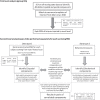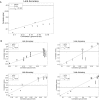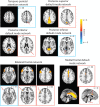Parallel ICA identifies sub-components of resting state networks that covary with behavioral indices
- PMID: 23087635
- PMCID: PMC3468957
- DOI: 10.3389/fnhum.2012.00281
Parallel ICA identifies sub-components of resting state networks that covary with behavioral indices
Abstract
Parallel Independent Component Analysis (para-ICA) is a multivariate method that can identify complex relationships between different data modalities by simultaneously performing Independent Component Analysis on each data set while finding mutual information between the two data sets. We use para-ICA to test the hypothesis that spatial sub-components of common resting state networks (RSNs) covary with specific behavioral measures. Resting state scans and a battery of behavioral indices were collected from 24 younger adults. Group ICA was performed and common RSNs were identified by spatial correlation to publically available templates. Nine RSNs were identified and para-ICA was run on each network with a matrix of behavioral measures serving as the second data type. Five networks had spatial sub-components that significantly correlated with behavioral components. These included a sub-component of the temporo-parietal attention network that differentially covaried with different trial-types of a sustained attention task, sub-components of default mode networks that covaried with attention and working memory tasks, and a sub-component of the bilateral frontal network that split the left inferior frontal gyrus into three clusters according to its cytoarchitecture that differentially covaried with working memory performance. Additionally, we demonstrate the validity of para-ICA in cases with unbalanced dimensions using simulated data.
Keywords: behavior; parallel ICA; resting state fMRI; resting state networks.
Figures





Similar articles
-
Non-linear ICA Analysis of Resting-State fMRI in Mild Cognitive Impairment.Front Neurosci. 2018 Jun 19;12:413. doi: 10.3389/fnins.2018.00413. eCollection 2018. Front Neurosci. 2018. PMID: 29970984 Free PMC article.
-
Automatic selection of resting-state networks with functional magnetic resonance imaging.Front Neurosci. 2013 May 20;7:72. doi: 10.3389/fnins.2013.00072. eCollection 2013. Front Neurosci. 2013. PMID: 23730268 Free PMC article.
-
Clusterwise Independent Component Analysis (C-ICA): Using fMRI resting state networks to cluster subjects and find neurofunctional subtypes.J Neurosci Methods. 2022 Dec 1;382:109718. doi: 10.1016/j.jneumeth.2022.109718. Epub 2022 Oct 6. J Neurosci Methods. 2022. PMID: 36209940
-
Altered Granger Causal Connectivity of Resting-State Neural Networks in Patients With Leukoaraiosis-Associated Cognitive Impairment-A Cross-Sectional Study.Front Neurol. 2020 Jun 10;11:457. doi: 10.3389/fneur.2020.00457. eCollection 2020. Front Neurol. 2020. PMID: 32655471 Free PMC article.
-
An introductory review of parallel independent component analysis (p-ICA) and a guide to applying p-ICA to genetic data and imaging phenotypes to identify disease-associated biological pathways and systems in common complex disorders.Front Genet. 2015 Sep 7;6:276. doi: 10.3389/fgene.2015.00276. eCollection 2015. Front Genet. 2015. PMID: 26442095 Free PMC article. Review.
Cited by
-
Global motion filtered nonlinear mutual information analysis: Enhancing dynamic portfolio strategies.PLoS One. 2024 Jul 11;19(7):e0303707. doi: 10.1371/journal.pone.0303707. eCollection 2024. PLoS One. 2024. PMID: 38990955 Free PMC article.
-
Assessing functional connectivity differences and work-related fatigue in surviving COVID-negative patients.bioRxiv [Preprint]. 2023 Jan 28:2022.02.01.478677. doi: 10.1101/2022.02.01.478677. bioRxiv. 2023. PMID: 35132408 Free PMC article. Preprint.
-
Characteristics of canonical intrinsic connectivity networks across tasks and monozygotic twin pairs.Hum Brain Mapp. 2014 Nov;35(11):5532-49. doi: 10.1002/hbm.22568. Epub 2014 Jul 1. Hum Brain Mapp. 2014. PMID: 24984861 Free PMC article.
-
Hippocampal functional connectivity is related to self-reported cognitive concerns in breast cancer patients undergoing adjuvant therapy.Neuroimage Clin. 2018 Jul 12;20:110-118. doi: 10.1016/j.nicl.2018.07.010. eCollection 2018. Neuroimage Clin. 2018. PMID: 30094161 Free PMC article.
-
A multi-site resting state fMRI study on the amplitude of low frequency fluctuations in schizophrenia.Front Neurosci. 2013 Aug 8;7:137. doi: 10.3389/fnins.2013.00137. eCollection 2013. Front Neurosci. 2013. PMID: 23964193 Free PMC article.
References
-
- Banich M. T., Milham M. P., Atchley R., Cohen N. J., Webb A., Wszalek T., et al. (2000). fMri studies of Stroop tasks reveal unique roles of anterior and posterior brain systems in attentional selection. J. Cogn. Neurosci. 12, 988–1000 - PubMed
Grants and funding
LinkOut - more resources
Full Text Sources
Miscellaneous

